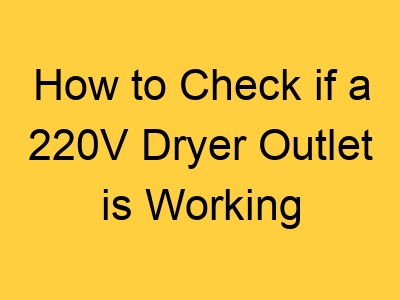Quck answer
To test a 220V dryer outlet, follow these steps:
1. Turn off the power: Before testing, ensure the power to the outlet is switched off to avoid electric shock.
2. Gather the necessary tools: You will need a multimeter, a device used to measure voltage, and a pair of insulated gloves for safety.
3. Set up the multimeter: Set the multimeter to measure AC voltage and select the appropriate range (usually 250V).
4. Test the outlet: Insert the multimeter’s probes into the outlet’s slots, one in each slot. The multimeter should display a voltage reading of around 220V. If there is no voltage or an incorrect reading, there may be an issue with the outlet.
5. Seek professional help: If the outlet is not functioning properly, it is recommended to contact a licensed electrician for further inspection and repairs.
Remember, safety is paramount when working with electricity. If you are unsure or uncomfortable, always consult a professional.
Before installing an electric dryer, it is important to test the 220 volt outlet to ensure that it is functional and capable of providing the appropriate voltage for safe and proper operation. Using a multimeter, also known as a VOM (Volt Ohm Meter), will provide an accurate and immediate reading of the outlet’s voltage. Attempting to use the dryer without conducting this test could result in damage to the dryer or electrical circuit if the voltage is incorrect.
Step 1
Locate the circuit breaker for the 220 volt dryer outlet in the main circuit panel, which is typically situated in the garage or utility room. The circuit breakers are labeled on the panel door, and the 220 volt circuit breaker is generally a larger two pole breaker.
Step 2
Turn on the multimeter and set the selector knob to the AC side. Choose the voltage setting that is closest to the expected outlet voltage. For instance, as a dryer outlet usually requires 220 volts, you should choose 220 to 240 VAC.
Step 3
Insert the two tester leads into the multimeter. Place the red lead into the red, positive (+) jack, and the black lead into the black, negative (-) jack. The jacks are typically color coded for easy identification and proper connection.
Step 4
Insert the two test leads (one each) into the two “hot” slots of the outlet. For a three-prong outlet, the two “hot” slots will be slanted; for a four-prong outlet, the two “hot” slots will be the two outermost vertical slots. The voltage should read between 220 to 240 volts after inserting the leads.
Step 5
Insert the red test lead into one “hot” slot and the black test lead into the neutral slot. For both three- and four-prong outlets, the neutral prong will be L-shaped. After inserting the leads, the voltage should read between 110 to 120 volts. Switch the red test lead to the other “hot” slot and the black lead into the neutral slot and check that the voltage again reads between 110 to 120 volts. Remove the test leads from the outlet and turn off the VOM.
Step 6
Plug the dryer cord into the dryer outlet for operation.
FAQ
1. How do I know if my dryer outlet is 220V?
You can check the voltage of your dryer outlet using a voltage tester or a multimeter. First, turn off the power to the outlet by switching off the circuit breaker or removing the fuse. Then, insert the probes of the tester or the multimeter into the two vertical slots of the outlet. If the reading shows around 220-240 volts, it means your dryer outlet is 220V.
2. Can I use a regular outlet tester to test a 220V dryer outlet?
No, a regular outlet tester is designed to test standard 120V outlets and cannot accurately measure the voltage of a 220V dryer outlet. It is recommended to use a voltage tester or a multimeter specifically designed for higher voltage outlets.
3. What if my dryer outlet is not 220V?
If your dryer outlet is not 220V, it may be a different voltage, such as 110V. In this case, you will need to consult a professional electrician to determine the appropriate voltage for your dryer and make the necessary electrical modifications to ensure safe and proper operation.
4. Can I convert a 110V dryer outlet to a 220V outlet?
Converting a 110V dryer outlet to a 220V outlet requires rewiring and potentially upgrading the electrical circuit. This is a complex task that should only be done by a licensed electrician to ensure compliance with electrical codes and safety standards. It is not recommended for DIY attempts.
5. Why is it important to test a 220V dryer outlet?
Testing a 220V dryer outlet is important to ensure that it is supplying the correct voltage required for your dryer to operate safely and efficiently. Using an outlet with the wrong voltage can cause damage to your dryer or pose a safety risk. Regular testing helps identify any electrical issues and allows for timely repairs or adjustments.
6. Can I test a 220V dryer outlet without any electrical knowledge?
While it is possible to test a 220V dryer outlet without electrical knowledge, it is strongly recommended to seek the assistance of a professional electrician. Working with electrical systems can be dangerous, and it is best to rely on trained experts who have the knowledge and equipment to perform the task safely and accurately.
7. How often should I test my 220V dryer outlet?
It is recommended to test your 220V dryer outlet at least once a year or whenever you suspect any issues with its performance. Regular testing helps ensure the outlet is functioning correctly and provides an opportunity to identify any potential electrical problems before they escalate. If you experience any unusual behavior from your dryer or notice any signs of electrical issues, it is advisable to test the outlet immediately.

